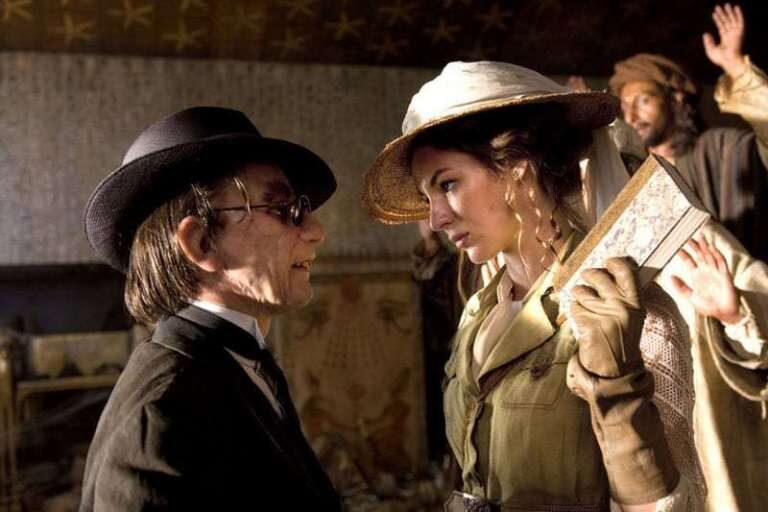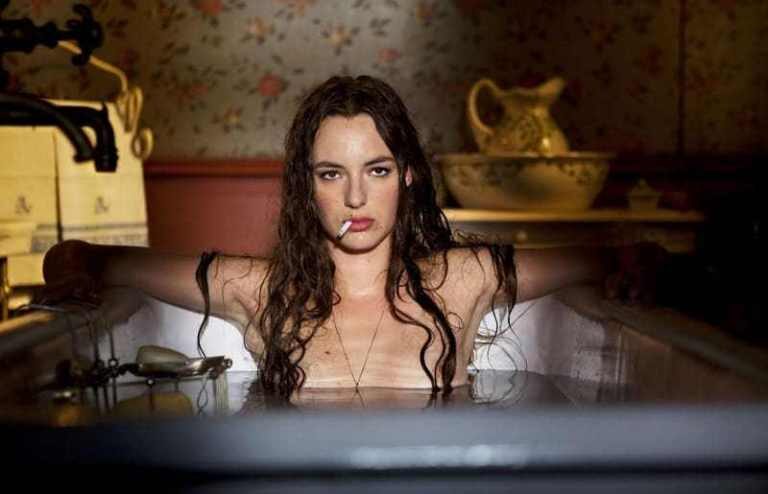Louise Bourgoin as Adèle Blanc-Sec: Feathers in Her Hat | Clothes on Film
Adèle Blanc-Sec is a comic strip heroine created by Jacques Tardi, perhaps little known outside of her native France but thanks to director Luc Besson and actress Louise Bourgoin, now bought vividly to life for the screen. Her world is akin to a fantasy Belle Époque. Period accurate 1910s attire by costume designer Olivier Bériot dotted among reanimated corpses and a giant winged lizard.
Despite Les aventures extraordinaires d’Adèle Blanc-Sec’s (The Extraordinary Adventures of Adèle Blanc-Sec) fabricated setting, Paris, 1912, at the time of the dinosaurs, Bériot has paid meticulous attention to ensuring costumes function within a historical context. He really understands the rigid formality of the era, making few concessions on necklines or hemlines, colour, fit or fabric.
 Louise Bourgoin as Adèle Blanc-Sec in her traditional safari attire.
Louise Bourgoin as Adèle Blanc-Sec in her traditional safari attire.
The only aspect of Bourgoin’s Blanc-Sec that ever feels exaggerated is her demeanour, so untamed and forthright in exclusively a man’s world. Yet this typifies her character; even buttoned up in whalebone corset, high muslin neck, folds of petticoats, walking skirts and ankle boots, she is a free spirit. Compared to the men around her suffocating inside their stiff wing collars, broadcloth jackets and bowlers, Adèle Blanc-Sec looks just as exciting as the ‘The Beautiful Era’ would imply.
It is worthwhile noting just how much sex appeal is bestowed on Blanc-Sec. Her clothing is more sexually suggestive than modern attire because it requires the spectator to merely imagine what is concealed within. At no point is Adèle Blanc-Sec exploited as an object of attraction; she just is by force of her own beauty. Even unexpected nudity in the (very European) bath scene keeps sexualisation in the background because Blanc-Sec is so casually comfortable with her own body. The viewer is challenged to remain as nonchalant as she is, particularly as a vital narrative pay-off unfolds at precisely the same moment.
 Nipples AND a cigarette? Shocking.
Nipples AND a cigarette? Shocking.
What stands out most with Adèle Blanc-Sec, however, are her hats. This is the era of wide brimmed, most extravagant affairs covered in flowers, petals, scarves, even grass. Basically the wider and more festooned with ornamentation the better. For those women in a financial position to comply, this was the perfect way to demonstrate social standing, much like the rising height of men’s top hats twenty years before. Blanc-Sec’s headgear is calm in comparison to the wild adventure she is caught up in, yet they still collapse over her brow under considerable weight of ostrich feathers and dried flowers.
Combined with a fur scarf she drapes over her shoulders, these hats form an instant point of recognition for the character. There is a subtle feathers correlation with the bird-centred subplot and calculated use of her fitted green coat (not a cloak as might have still been fashionable), which connects Adèle Blanc-Sec to Bécassine, the comic book protagonist originally created as Tardi’s heroine before he become more interested in Blanc-Sec. Bériot and Besson use the coat at two critical junctures; to introduce bestselling author Adèle Blanc-Sec at a book signing and when she discovers a last ditch way to save her comatose sister from a living death.
 Adèle’s green coat; subtle reference to Tardi’s original comic book heroine Bécassine.
Adèle’s green coat; subtle reference to Tardi’s original comic book heroine Bécassine.
“Into my arms!” Blanc-Sec demands at least three times in the story, seconds before pouncing on her ‘victim’ with enough force to knock them flying (a mummified corpse in a sarcophagus first time around). This neatly sums up the go getting, never give up attitude of the character. More than a female Indiana Jones, although the hat silhouette makes for an understandable parallel, she demands better than lazy gender comparison. With the ending of Les aventures extraordinaires d’Adèle Blanc-Sec left so enticingly open, she demands a sequel.
© 2011 – 2020, Lord Christopher Laverty.